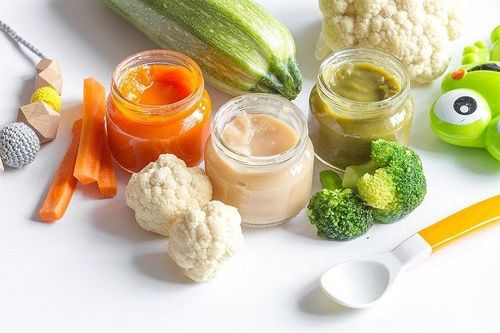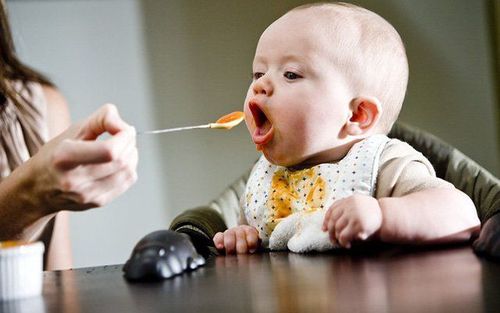This is an automatically translated article.
When children enter the weaning stage, parents have a headache with choosing the method of eating and food for the child. So how have parents determined to give their children solid foods? What are the different methods of weaning and what is a reasonable weaning for children?
1. What is a reasonable way to feed babies?
When the baby is 6 months old, in addition to the main source of nutrients is still breast milk, the baby needs to be supplemented with other foods, this stage is called the baby's weaning phase and needs to be done. a reasonable way. At first, when weaning is new, children should be given food from liquid to solid, from little to more, to gradually get used to new foods. The increase in the amount of food and meals for children should be appropriate for the age of the child, ensuring that the food is suitable for the child's taste. When preparing baby food, make sure that the food is soft, easy to chew and easy to swallow. Processing equipment must be clean, the processor needs to wash his hands before preparing food and when feeding children. Do not give MSG to children because this spice has no nutrients and is not good for the health of children.
Most of the fresh, clean, and nutritious foods that adults eat every day can be eaten by children. Complementary foods during the baby's weaning can be divided into 4 groups:
Protein-rich foods include: meat, fish, shrimp, crab, eggs, milk, beans, peanuts, sesame... Group Starch includes: rice, noodles, potatoes, corn... The fat group includes: oil, fat, peanuts, sesame... The group rich in vitamins and minerals includes: vegetables, fruits, especially vegetables. dark green and red or yellow fruits. A reasonable weaning diet for children needs to ensure adequate supply of the above groups of nutrients in addition to breastfeeding or formula milk.
2. Methods of infant feeding and 3-in-1 weaning methods
2.1. Traditional weaning methods Traditional weaning methods have existed for a long time, and are used by many parents to feed their children weaning. When children reach the age of weaning, their parents will begin to feed them with powdered flour mixed with other foods such as vegetables, fish, meat... And when the child turns teething, parents will switch to the child to eat porridge and other soft foods attached.
Nowadays, many mothers think that the traditional method of weaning is no longer suitable for modern trends. However, there are still many children in Vietnam who are fed this way.
The advantage of the traditional weaning method is that it can help parents save time by simple processing. This method is suitable for parents who are too busy. At the same time, pureed food is easy to digest, and does not affect the child's ability to digest and absorb food.
The limitation of the traditional weaning method is that children eat a lot of pureed foods, slow down the ability to eat raw foods. Many children over 2 years old still have to eat pureed rice, which is very unhygienic. In addition, the processing of many foods together makes it difficult for children to feel the unique flavors of different types, not stimulating children to eat. Children are prone to anorexia, anorexia and picky food later on.

Các phương pháp cho trẻ ăn dặm không thể bỏ qua ăn dặm truyền thống
2.2. Japanese-style weaning method Vietnamese people always prefer the intelligent parenting methods of countries around the world, especially those of the Japanese. With the Japanese-style weaning method, parents of children will start to introduce solid foods from the time the child is 5-6 months old. The ratio of diluted porridge is 1:10. The coarseness of the porridge is gradually increased with the age of the child. In addition, according to this weaning method, children can also eat other foods such as meat, fish, green vegetables, ... with suitable rawness.
With the Japanese-style weaning method, it will help children eat a variety of foods separately with all 3 food groups: starch - vitamin - protein according to the standard: "yellow - red - green". The foods are not mixed together, but are processed separately for each baby's food tray. In addition, children are taught to eat light foods, from vegetables to meat and fish to get used to different foods. The most important thing according to this method of weaning is that parents do not have to take their children around and force them to eat and drink.
Japanese-style weaning brings a number of advantages such as:
Japanese-style weaning method will help children have the ability to eat rough foods earlier than the traditional weaning method. Help children eat different food groups separately and help them get used to many flavors, not get bored and form a taste for favorite foods. This method of weaning helps children get used to eating bland foods and is therefore beneficial for their kidneys. Finally, this method of weaning helps children have a comfortable mentality, eat without pressure, focus and eat more. Although it offers many positive advantages, Japanese-style weaning also has certain limitations:
Parents spend a lot of time and effort teaching their baby to sit, hold a spoon, and eat. The preparation of foods is also very time consuming. Therefore, this method is suitable for mothers who are less busy, have more time and are meticulous in preparing baby food. If the mother chooses this method of weaning, she needs to arrange a reasonable timetable.
2.3. Self-directed weaning method Self-directed weaning (English name is Baby Led Weaning and abbreviated: BLW) is a self-directed weaning method, that is, babies decide what to eat and what foods to eat. before or after without adult assistance.
In addition, in this method, the child has the right to eat or not eat a certain food according to personal preferences. The baby can pick it up by hand or use a spoon, spoon or fork to eat with absolutely no parental intervention. Self-directed weaning is a method of weaning where parents respect their children's decision-making during the eating process and the baby will discover and enjoy the foods he wants.
The most important thing is that the mother is not allowed to feed, coax or force the baby to eat, eat less or eat more and how to eat is up to the baby. Children will be eating at the same table, at the same time as other family members.
In general, self-directed weaning will encourage your baby to combine solid foods with breastfeeding (formula) so it's not like other types of weaning, babies will have more choices than foods previously milled.
Self-directed weaning originated in European and American countries. In Vietnam in the past few years, this method has only been applied by parents because of its superior benefits compared to normal weaning.
The typical benefits of this method are helping children develop skills, develop senses, create independence, reduce the risk of obesity, help children increase emotions in eating

Ăn dặm tự chỉ huy là một trong các phương pháp cho trẻ ăn dặm
The best time to start introducing self-directed solids is from 6 months and up. This is the advice of the World Health Organization WHO for mothers who are preparing to apply this method of weaning to their children. When your baby is 6 months old, you should introduce solid foods to let your baby get used to it, but remember that the main food is still breast milk.
2.4. 3-in-1 weaning method The three weaning methods described above are considered the 3 most popular weaning methods in Vietnam today. Currently, these three methods are still being applied by many Vietnamese mothers to their children. Each method of weaning will have its own advantages and disadvantages.
From these 3 methods of weaning, a whole new method of weaning was born. With a flexible combination of the above methods of weaning, the 3-in-1 weaning method helps babies have a fun, light and highly effective eating experience.
Two methods of Japanese weaning and self-directed weaning, the baby will not eat much, the baby will grow slower while the babies using the traditional weaning method will eat more and gain weight well than. However, the outstanding effects of the above two methods of weaning are undeniable. At that time, the baby will have better food processing skills, better chewing ability, he will be more interested in food and meals. In addition, the mother will know how the baby's taste is, whether the baby likes to eat fish or eat meat... Plus, the mother will better detect whether her baby is allergic to any food or not. are not. Based on the principles of the above two opposite methods of weaning, the 3-in-1 weaning method was officially born. Depending on family conditions, parents can flexibly apply or change this method of weaning. Weaning meals will be combined with each other.
The application of 3-in-1 weaning method allows mothers to customize the method of weaning for their children depending on their child's condition. Many babies will be better suited to Japanese-style or self-directed weaning, but many will feel more comfortable with traditional weaning. In addition, the mother should also pay attention to the roughness of the food to improve the baby's chewing ability and oral muscle function.
The four methods of weaning above all have their strengths and weaknesses, so which method of feeding babies depends entirely on both mother and baby, parents can choose the most suitable method with the baby and the mother's condition. Mothers can also refer to other mothers, take advantage of the strengths of each method to create their own eating patterns, for example, traditional food preparation, but should pay attention to the steps of raw food, how to give food. children eat, practice giving them light food, focus on eating instead of going around.... Or even combine many methods of weaning in children's meals during the day. The most important thing is to help your baby have delicious and happy meals.
Weaning is one of the important stages in a child's development to provide them with all the nutrients they need besides breast milk. This is also a period that causes parents headaches in choosing foods, planning and menus for babies. Besides, choosing a suitable weaning method is also a concern of many parents. Each method of weaning has different advantages and disadvantages, they can also be combined to create the most suitable method for each situation of mother and baby to create delicious and nutritious meals. for children.
For more nutritional knowledge and child care for each age, parents should regularly visit the website vimec.com and make an appointment with the leading doctors, pediatric and nutrition experts of the National General Hospital. Vinmec when needing advice on children's health.













